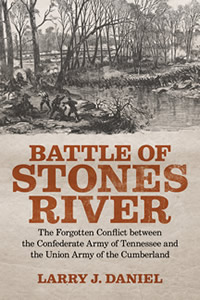Death in Murfreesboro
The Battle of Stones River finally gets its due from historian Larry J. Daniel
Even in the generally underappreciated history of the western theater of the Civil War, the Battle of Stones River gets little respect. Shiloh, Franklin, and Chattanooga are the most remembered of the big Tennessee battles, despite the fact that a portion of the field on which tens of thousands fought has been designated the Stones River National Battlefield and is also home to a national cemetery. The commanding generals of the bloody New Year’s struggle near Murfreesboro were not Lee or Grant or Sherman or Jackson, the rock stars of Civil War generals. No bestselling novel has brought the battle to public awareness. Indeed, a majority of Americans have almost certainly never heard of Stones River, let alone know who fought or won there. In Battle of Stones River: The Forgotten Conflict between the Confederate Army of Tennessee and the Union Army of the Cumberland historian Larry J. Daniel has set out to correct that lack of knowledge. He believes it is time to give the battle its due as one of the most important of the War Between the States.
By late 1862 Union forces had occupied Nashville for nearly a year, and leaders in Washington believed it was past time to push the rebels completely out of Middle Tennessee. President Lincoln was getting very worried about the course of the war. As Daniel notes, “By the fall of 1862, support for the war had waned in the North.” Lincoln feared for the future of the country if he could not show the public that their sacrifices were resulting in victories. In the eastern theater that December, Union forces suffered a terrible defeat at Fredericksburg, resulting in even greater pressure on the western generals, who had often been more successful but who had as yet failed to secure all of Tennessee. With Grant occupied in the Mississippi River valley, the task—and high expectations—fell to Major General William S. Rosecrans, who had distinguished himself in October by defeating a Confederate army near Corinth, Mississippi, and who soon endeared himself to the troops in Nashville.
 Opposing Rosecrans was General Braxton Bragg, a man who had difficult relations with several of his corps and division commanders and whose abilities were constantly doubted by political and military leaders in Richmond. In fact, Bragg and Rosecrans were pretty evenly matched in both tactical ability and forces at their command. When Rosecrans marched south and east from Nashville that December, he wielded a force of over 41,000 men against Bragg’s 35,000. Bragg gathered his forces at Murfreesboro, on the banks of the Stones River, and waited. When the armies began poking and prodding each other on December 30, both Bragg and Rosecrans used their imperfect knowledge of the enemy’s position to develop battle plans for the following day, New Year’s Eve, 1862. Their plans, like their armies, were nearly identical—each wanted to strike the other’s right flank, like two boxers throwing simultaneous left hooks. During that long, cold night of anticipation, bands on both sides played to keep the troops’ spirits up. “One of the Federal bands then began playing ‘Home Sweet Home,’” writes Daniel. “As if by orchestration, a Confederate band joined in, creating a surreal moment of harmony.” At dawn, Bragg landed the first blow.
Opposing Rosecrans was General Braxton Bragg, a man who had difficult relations with several of his corps and division commanders and whose abilities were constantly doubted by political and military leaders in Richmond. In fact, Bragg and Rosecrans were pretty evenly matched in both tactical ability and forces at their command. When Rosecrans marched south and east from Nashville that December, he wielded a force of over 41,000 men against Bragg’s 35,000. Bragg gathered his forces at Murfreesboro, on the banks of the Stones River, and waited. When the armies began poking and prodding each other on December 30, both Bragg and Rosecrans used their imperfect knowledge of the enemy’s position to develop battle plans for the following day, New Year’s Eve, 1862. Their plans, like their armies, were nearly identical—each wanted to strike the other’s right flank, like two boxers throwing simultaneous left hooks. During that long, cold night of anticipation, bands on both sides played to keep the troops’ spirits up. “One of the Federal bands then began playing ‘Home Sweet Home,’” writes Daniel. “As if by orchestration, a Confederate band joined in, creating a surreal moment of harmony.” At dawn, Bragg landed the first blow.
 The fight that followed was as vicious as any of the war. The Union right crumbled under the pressure, but not without inflicting horrific losses on Bragg’s forces. Daniel’s unit-by-unit account of that first day of battle is a litany of disaster for both sides. Typical of the carnage was what happened near the Three Mile Marker along the Nashville Pike, as Rosecrans’s forces resisted the Southern onslaught. A brigade of Texas soldiers tried to take a position held by Union artillery. “To the left of the Chicago battery, the Texans managed to get within fifteen to twenty yards of the muzzles of the Pennsylvania battery before being hurled back. The Texans left their dead in heaps—nineteen bodies in a single pile.” Of the action along another portion the line, where over 900 Blue and Gray died within forty-five minutes, Daniel observes simply, “It had been mutual annihilation.” The fighting was so intense, so bloody, that Union veterans of the mass destruction at Shiloh said they’d prefer another day there to fifteen more minutes at Stones River.
The fight that followed was as vicious as any of the war. The Union right crumbled under the pressure, but not without inflicting horrific losses on Bragg’s forces. Daniel’s unit-by-unit account of that first day of battle is a litany of disaster for both sides. Typical of the carnage was what happened near the Three Mile Marker along the Nashville Pike, as Rosecrans’s forces resisted the Southern onslaught. A brigade of Texas soldiers tried to take a position held by Union artillery. “To the left of the Chicago battery, the Texans managed to get within fifteen to twenty yards of the muzzles of the Pennsylvania battery before being hurled back. The Texans left their dead in heaps—nineteen bodies in a single pile.” Of the action along another portion the line, where over 900 Blue and Gray died within forty-five minutes, Daniel observes simply, “It had been mutual annihilation.” The fighting was so intense, so bloody, that Union veterans of the mass destruction at Shiloh said they’d prefer another day there to fifteen more minutes at Stones River.
After two more days of fighting, Rosecrans held, giving the North a much needed New Year’s boost and effectively ending Confederate hopes of recapturing Nashville. Bragg, having lost the confidence of his officers and more than half his fighting force, ordered a retreat below the Duck River. In the spring of 1863, Rosecrans would outmaneuver Bragg in a nearly bloodless campaign that finally drove the Army of Tennessee from its home state. The field at Stones River would fall silent and fill with graves, a perfect reminder of the war of attrition that the Civil War was becoming. As Daniel demonstrates in his detailed, scholarly account of this western turning point, “The South could not win such a war.”


